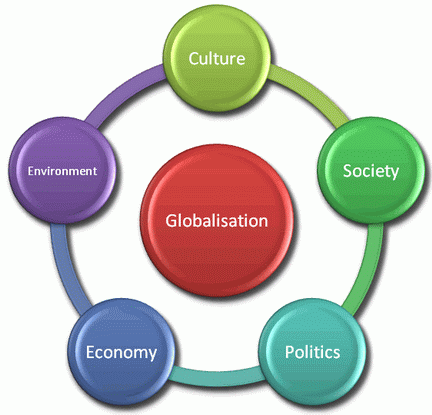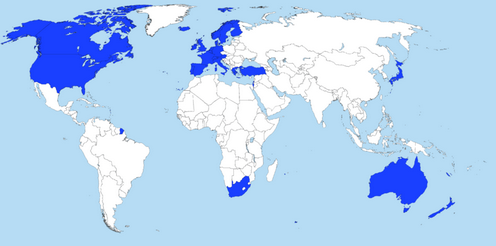What is globalisation
Globalisation means the integration of national economies into the international economy through trade, foreign direct investment, capital flows, migration, and the spread of technology.
According to dictionaries
Globalisation (n) is the "process enabling financial and investment markets to operate internationally, largely as a result of deregulation and improved communications" (Collins) or - from the US - to "make worldwide in scope or application" (Webster). The financial markets, however, are where the story begins.

Promotion of free trade:
- Elimination of tariffs; creation of free trade zones with small or no tariffs
- Reduced transportation costs, especially resulting from development of containerization for ocean shipping.
- Reduction or elimination of capital controls
- Reduction, elimination, or harmonization of subsidies for local businesses
- Creation of subsidies for global corporations
- Harmonization of intellectual property laws across the majority of states, with more restrictions.
- Supranational recognition of intellectual property restrictions (e.g. patents granted by China would be recognized in the United States)
Benefits of Globalisation
- By buying products from other nations customers are offered a much wider choice of goods and services.
- Creates competition for local firms and thus keeps costs down.
- Globalisation promotes specialisation. Countries can begin to specialise in those products they are best at making.
- Economic Interdependence among different nations can build improved political and social links.
Drawbacks of Globalisation
- Cheap imports from developing nations could lead to unemployment in developed countries where the cost of production is high.
- Choosing to specialise in certain products may lead to unemployment in other sectors which are not prioritised.
- Increased competition for infant industry.
- ‘Dumping’ of goods by certain countries at below cost price may harm industries in order countries.
Explore these sites about Globalisation:
Teaching resources on Globalisation: http://www.unesco.org/education/tlsf/mods/theme_c/mod18.html
What is a developed economy?
Countries with economies in which the tertiary and quaternary sectors of industry dominate are known as developed economies. This level of economic development is usually determined on the following factors:
High income per capita
"High income economies" are defined by the World Bank as countries with a Gross National Income per capita of $11,456 or more. According to the United Nations definition some high income countries may also be developing countries. Thus, a high income country may be classified as either developed or developing.
High Human Development Index (HDI)
The Human Development Index (HDI) is an index combining normalized measures of life expectancy, literacy, educational attainment, and GDP per capita for countries worldwide. The basic use of HDI is to rank countries by level of "human development", which usually also implies to determine whether a country is a developed, developing, or underdeveloped country.
High gross domestic product (GDP) per capita
Traditionally, Canada and the United States in North America, Japan in Asia, Australia and New Zealand and most countries in Northern Europe and Western Europe have been considered "developed countries". These economies generally have a per capita GDP in excess of $10,000.

For further details refer to the following links
- IMF (advanced economies)
- The Economist (quality of life survey)
- The World Factbook (developed countries)
- United Nations Statistics Division (definition)
- United Nations Statistics Division (developed regions)
- World Bank (high-income economies)
What are developing countries?
The development of a country is measured with statistical indexes such as income per capita (per person) (GDP), life expectancy, the rate of literacy. Countries are categorised as less developed because of their poverty and low average incomes, their lack of good human resources and their low level of economic diversification.
HOT QUESTION: Explain what is likely to be the occupational distribution of the population in a less developed country?
SUGGESTED ANSWER: Most of the workforce is engaged in agriculture and other primary industries, with some in manufacturing and some in service industries. Many of these jobs will be poorly paid.
Developing countries are in general countries which have not achieved a significant degree of industrialization relative to their populations, and which have, in most cases a medium to low standard of living. There is a strong correlation between low income and high population growth.
Other terms sometimes used are less developed countries (LDCs), least economically developed countries (LEDCs)
Characteristics of a less developed economy
These economies are marked by a
- high birth rate,
- relatively high death rate and
- a low life expectancy
- high population growth
- High dependency ratio
- Low GDP per capita.
- Lower proportion of population is enrolled in education
- Low level of living standard
- Poor health due to poor nutrition, lack of access to facilities such as clean water and proper sanitation.
- Health care provisions are of often poor.
Structure of the Economy
These economies are more reliant on primary sector.
They export certain primary commodities, agricultural goods and low technology products.

| Advanced economies |
| Emerging and developing economies (not least developed) |
| Emerging and developing economies (least developed) |
Difference between developed economy and less developed economy
Developed economy |
Less developed economy |
|
Population |
low birth rate higher life expectancy low death rate due to better medical facilities aging population
|
Developing countries have higher rate of natural increase. Death rates have fallen faster than birth rates; birth rates are significantly higher than in developed countries, whereas death rates are only somewhat higher than in developed countries. Tradition, lack of contraception, poverty and lack of education are the main causes of high population growth rate. |
Education |
High level of literary, Highly trained workforce. Workers are paid high rates of wages. |
Low level of literacy with low skill levels of the workforce results in low wages of the workforce. Government is the main provider of education services and have low percentage of public expenditure allocated for education. |
Economic structure |
These economies usually have a larger tertiary sector and most of the workforce is engaged in service industries. The country produces and exports high technology products or high value added goods. |
Primary sector is the major contributor to the GDP of the country. Low GDP per capita is there. Usually exports agricultural goods or natural resources and imports value added goods from developed countries. |
Barriers to growth of less developed economies
Rapid population growth neutralises growth in GDP. The ultimate effect is that GDP per capita remains the same or comes down.
Human resources: Lack of training and high level skills makes the workforce less productive.
Lack of natural resources: If the country is lacking in natural resources, growth can be difficult. Moreover, if the country has good natural resources, but they are not managed properly then there will be less development.
Inefficient use of resources: If there is no optimum utilisation of workforce, or if the firms are inefficient due to lack of competition.
Too much dependence on agricultural products: Developed countries which import these products from less developed countries usually pay very low prices for it. Moreover, they further process these products and sell it for higher prices to LDCs.
Poor infrastructure: Lack of infrastructure such as poor transport and communication is another reason which hinders growth for LDCs.
Helpful Resources





